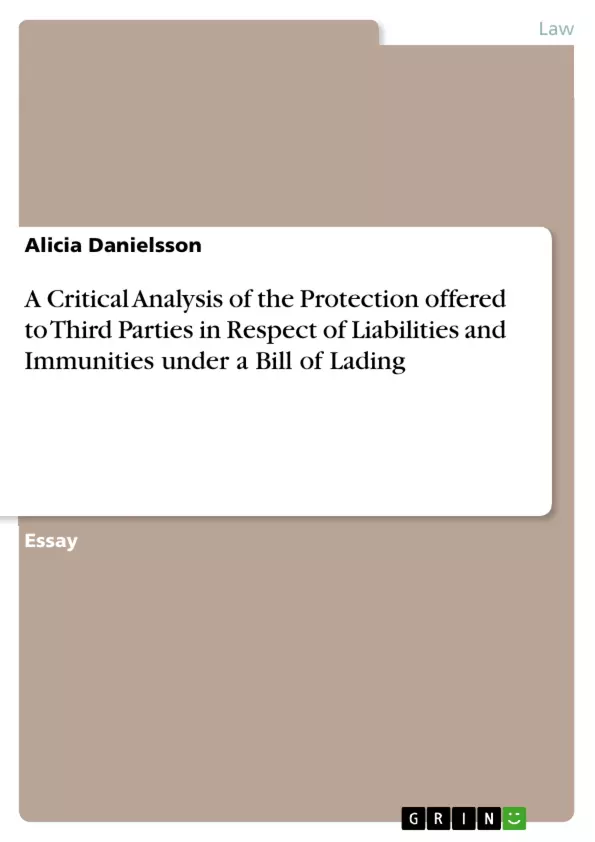The transportation of goods between exporters in one country and importers in another is one of the most important elements of international commerce and thus constitutes a significant part of an international sales contract. Even today, a large amount of cargo is still transported from one country to another by sea. Thus, bills of lading continue to play a crucial role. As defined by Lord Justice Blackburn in “Blackburn on the Contract of Sale” , a bill of lading is "[a] writing signed on behalf of the owner of ship in which goods are embarked, acknowledging the receipt of the Goods, and undertaking to deliver them at the end of the voyage, subject to such conditions as may be mentioned in the bill of lading." For a carrier, a bill of lading serves as evidence of a shipping contract and contains the terms of carriage. In particular, as any agreements not specified on the bill of lading do not affect third parties, the bill plays a crucial role in international trade.
In terms of international universal rules which are applicable for international carriages, and especially bills of lading, the most influential sets of rules are the Hague Rules and the Hague-Visby Rules, as well as the Hamburg Rules. Accordingly, the responsibilities and liabilities of carriers in cases in where goods are being transported on the basis of bills of lading are determined by the Hague and the Hague-Visby Rules, which are widely accepted in this realm. The Hamburg Rules, in contrast to the previous two, has found itself under more political pressure from developed nations and hence defines responsibilities of carriers in a wider fashion. However, due to this, it has not been as widely ratified and is, thus, more limited in its application.
However, due to the less wide net of the Hague-Visby Rules in relation to the period of responsibility as well as definitional issues regarding the limitation of liability and immunities of third parties in bills of lading, there is still a sense of uncertainty in the area of carriage contracts.
These will be briefly discussed in the following. A particular focus will be placed on the issues in defining third parties and the mechanisms used to link the effects of tortious claims to contractual claims under international uniform law. This will be followed by an examination of the rationale and legitimacy issues of Himalaya clauses to grant third parties liability protection under universal international law.
Inhaltsverzeichnis (Table of Contents)
- I. Introduction
- II. Definitional issues in the protection of third parties under international uniform law
- III. Mechanisms to link the effects of tortious claims to contractual claims under international uniform law
- IV. The idea behind the Himalaya clause and the protection of third parties under uniform law
- V. The issue of legitimacy of the Himalaya clause
- VI. Conclusion
Zielsetzung und Themenschwerpunkte (Objectives and Key Themes)
This document explores the legal framework surrounding the protection of third parties in international carriage contracts, focusing specifically on the application of the Hague-Visby Rules and the implications of the Himalaya clause.
- Defining "third parties" in the context of international carriage contracts
- Examining the mechanisms used to link tortious claims to contractual claims
- Analyzing the rationale and legitimacy of the Himalaya clause in providing liability protection to third parties
- Investigating the legal challenges associated with extending statutory protection to various actors in the transportation chain
- Assessing the scope and application of the Hague-Visby Rules in relation to third-party liability
Zusammenfassung der Kapitel (Chapter Summaries)
The introduction provides a general overview of the role of bills of lading in international trade and highlights the significance of the Hague-Visby Rules in regulating carrier liability. It also introduces the concept of the Himalaya clause and its potential impact on third-party protection.
Chapter II delves into definitional issues surrounding the protection of third parties under international uniform law, specifically focusing on the interpretation of the Hague-Visby Rules and their application to different categories of individuals involved in the carriage process. The chapter examines the distinction between "servants and agents" and "independent contractors" and the implications of this distinction for liability protection.
Chapter III explores the mechanisms used to link tortious claims to contractual claims under international uniform law. It examines how the Hague-Visby Rules allow for the extension of liability protection to third parties acting within the scope of their duties. This chapter also discusses the limitations of this protection, particularly in relation to reckless conduct or intentional harm.
Chapter IV delves into the idea behind the Himalaya clause and its role in providing liability protection to third parties under international uniform law. It explores the rationale for extending contractual protections to third parties involved in the carriage process and examines the legal basis for such an extension.
Chapter V focuses on the issue of legitimacy surrounding the Himalaya clause. It examines the arguments for and against the use of this clause, highlighting potential legal challenges and uncertainties associated with its application.
Schlüsselwörter (Keywords)
The key terms and concepts explored in this text include: international carriage contracts, bills of lading, Hague-Visby Rules, Himalaya clause, third-party liability, tortious claims, contractual claims, servants and agents, independent contractors, legal challenges, statutory protection, transportation chain, and legal uncertainties.
- Quote paper
- Alicia Danielsson (Author), 2015, A Critical Analysis of the Protection offered to Third Parties in Respect of Liabilities and Immunities under a Bill of Lading, Munich, GRIN Verlag, https://www.grin.com/document/303291



